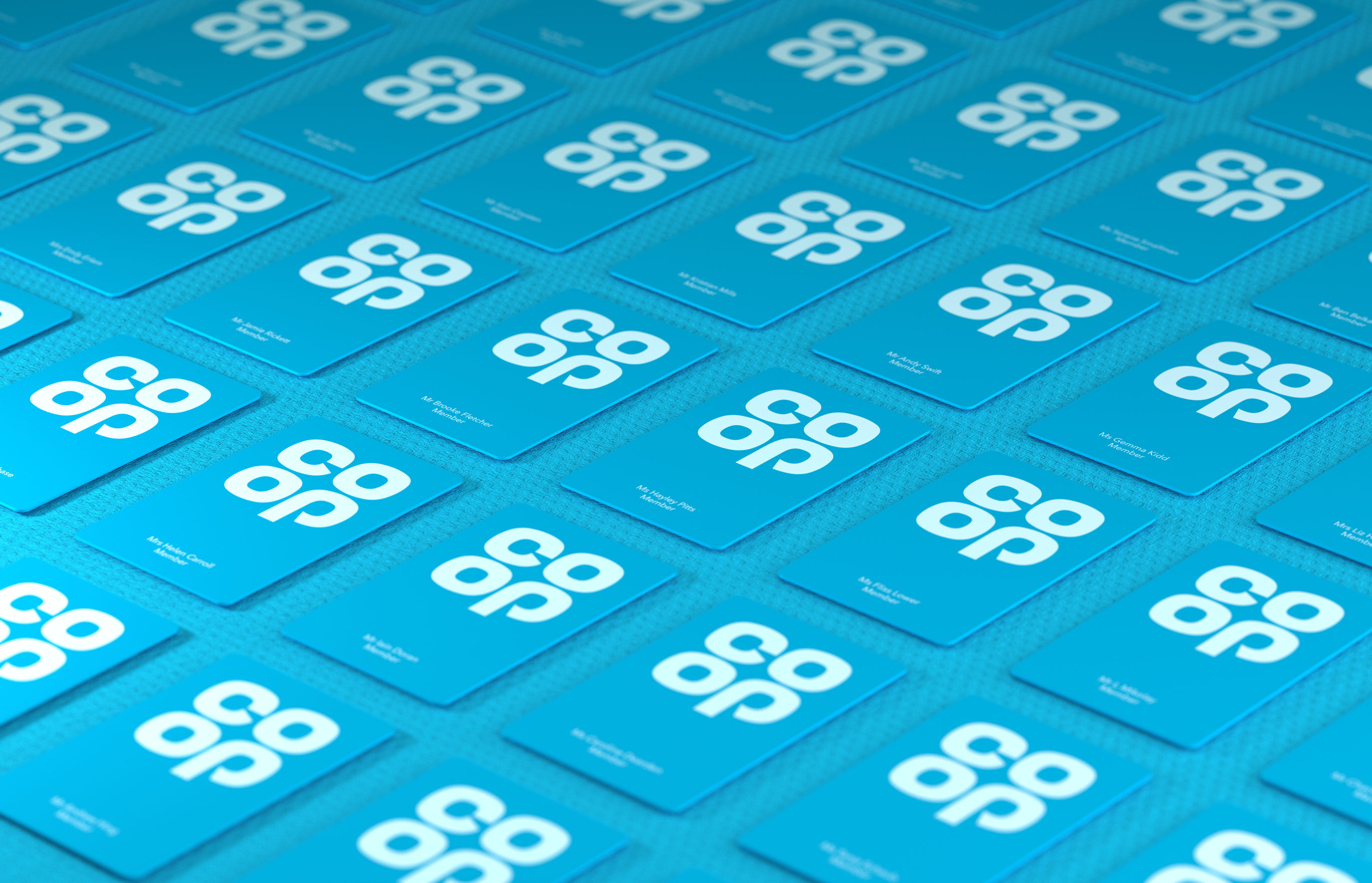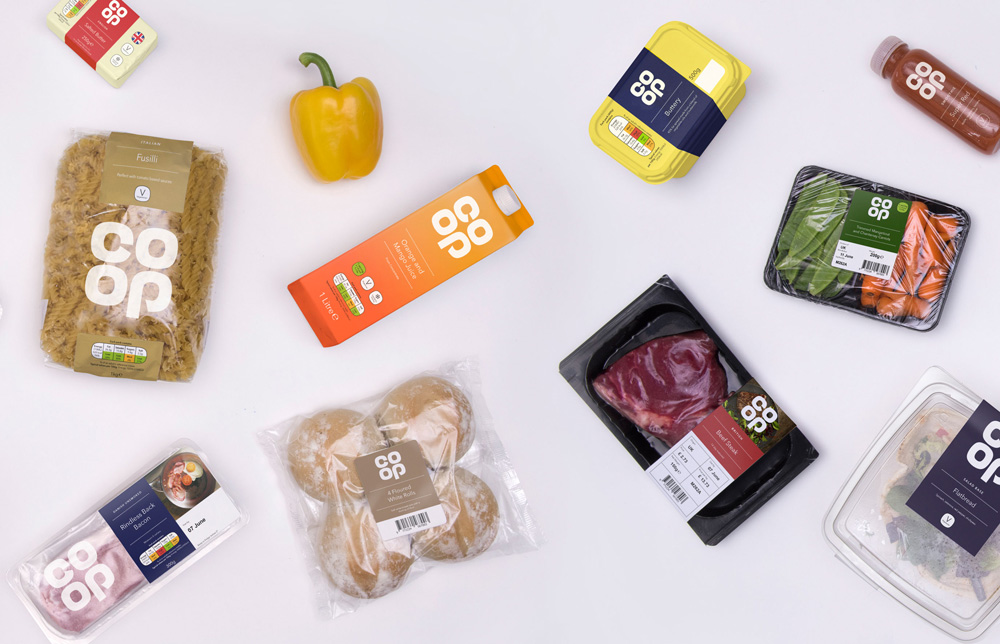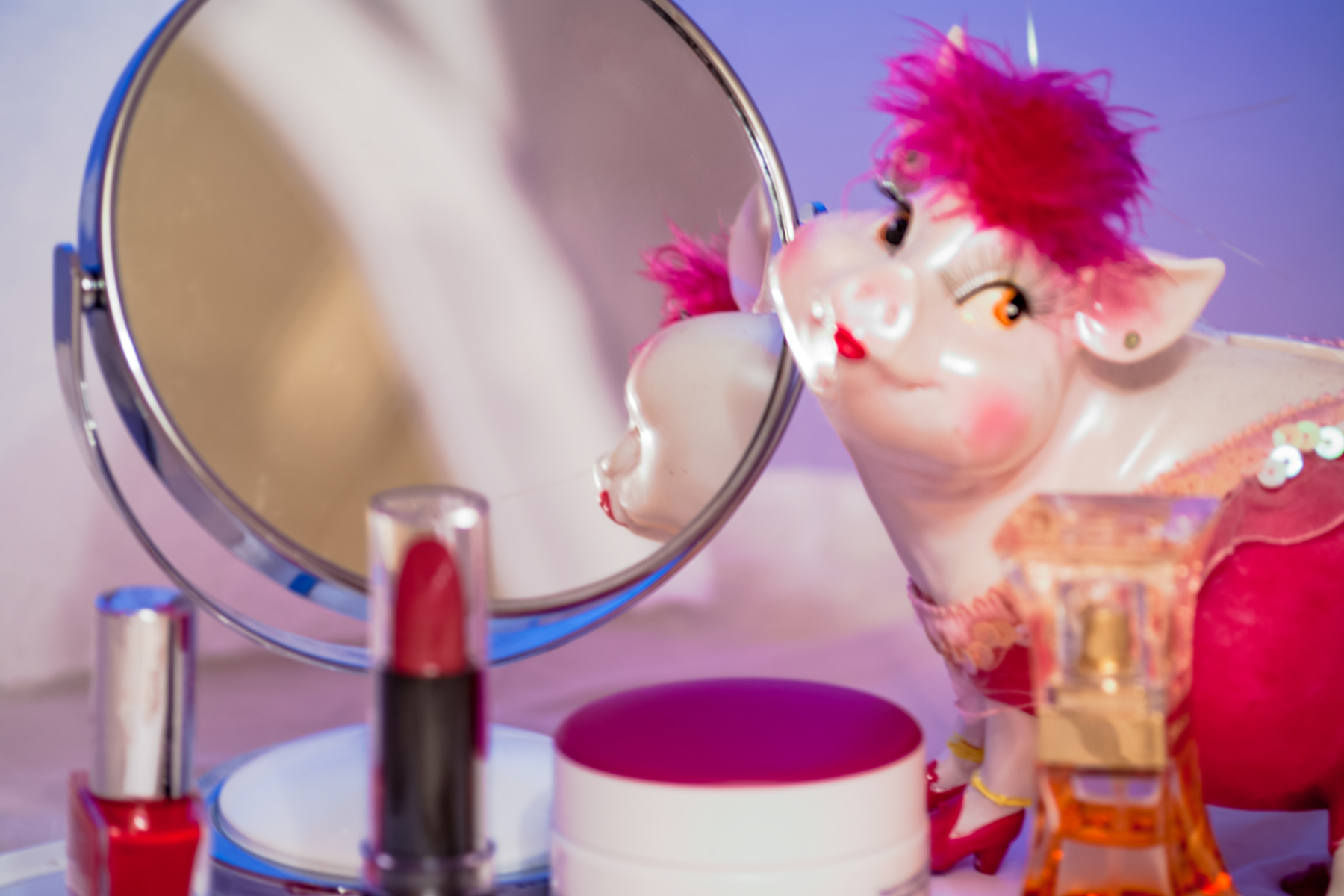I so often look to the past for inspiration designing for the future. The recent Co-op rebrand is a perfect example of this – to the extreme – recreating a modernised version of the 1968 Cloverleaf logo, which has been designed as a visual reminder of the company’s roots.
I think it works on many levels. It’s iconic, distinct, clean and modern giving a fresh and simple feel to reflect the Co-op today and its range of services and products. The brand is impactful and consistent across all media: food packaging, bags, brochures and livery. With a fresh new colour palette and fonts.
One thing I always hark on about when I’m taking to clients about rebranding is brand personality. Often this hasn’t even been thought about or it just gets lost in the detail of the dry facts of ‘what we do and how we do it’. It really is so important though, so customers have an emotional attachment to the brand as well as a rational one. It’s often how we make a final decision deciding between two similar products or services from different companies.
By looking to the past the Co-op has successfully achieved this. For the older generation it evokes nostalgia but also a company that is happy to move with the times. For the younger generation it suggests a modern brand of the future, ready to live and breathe in the retail and digital world.
Thumbs up Co-op and North – nice job!
Bag

Stationary

Packaging

back to all news or you may also be interested in the news below:
TWEET OR TWO
To ensure you stay in the loop and receive our news, updates and general musings hot off the press, follow us on Twitter now. We promise not to bombard you!
Professional Services Marketing – some tips
When your average Jo thinks of ‘professional services’ they probably start out with an image in black and white, add in a pin striped suit, crusty offices with carpets still telling the stories of the 80s heydays, of bare walls and piles of files containing paper. Of long boozy lunches, inappropriate behaviour and a slap on the secretary’s backside.
Is this really the professional services firm of today? The lawyer, accountant, recruiter? It certainly shouldn’t be!
Over the past few years, Journey has been lucky enough to work with a new breed of professional services firms. Lawyers who disrupt the playing field with fresh ideas, accountants who not only set the pace, but reinvent the rules in how it is executed. Recruitment companies who view the world from the client AND the candidate’s perspective.
All of these firms have one thing in common – they’re entrepreneurs. They don’t want to do it how it’s always been done, they want to change how it is done. Not only developing a great image for themselves, but improving the image of their industry, pulling ahead of their peers and appealing to the wider audience – with a new message. ‘We understand you’. Yes that’s right, it’s that simple.
When I look at the firms we are lucky enough to work with, what is the single, most positive attribute they have on show? It’s just that, understanding what their clients want, listening to them and adapting their services to their client’s needs, not shoehorning them into a ‘one size fits all’ offering – whilst of course delivering a first class service.
For a while, this new breed of firm has been able to dine out on their ‘joie de vivre’ so rare has it been in their industry, but with so many of these disruptive and often ‘boutique’ or ‘specialist’ firms on the rise, it is more important than ever to ensure they convey exactly what their ‘pièce de résistance’ is.
Pretty soon, the perceived norm will shift, the disruptors will have disrupted and the tectonic plates beneath the surface of these industries will have changed the landscape forever. Understanding your clients will become the expectation, not the exception, being seen to be part of their wider management team will be the norm.
How then do you delve deeper? Really establish that personality behind your brand? Delivering that succinct message that runs through every living, working part of your business from your networking events through to your first meeting with a prospective client?
At Journey, we love working with entrepreneurial businesses, getting under their skin, challenging them and pulling out those true nuggets that set them apart from their closest competitors. So, next time you consider yourselves to be far from average, remember that average is changing – the heat is rising and you need to stay one step ahead.
We can help you stay well ahead of average.
back to all news or you may also be interested in the news below:
TWEET OR TWO
To ensure you stay in the loop and receive our news, updates and general musings hot off the press, follow us on Twitter now. We promise not to bombard you!
You’re not the only one with great ideas!
‘I wish my staff took the initiative! ‘That was a comment made to me in a recent meeting with someone. His particular concern was people waiting to be told what to do or for ideas, and not just taking the initiative and doing it. So it got me thinking, ‘why wouldn’t they?’ Of course after further conversation and a better understanding of this particular scenario, it became clear that these guys don’t feel valued and don’t believe their ideas or actions would be appreciated. The reason for that, I believe, is because they have no formal ‘platform’ or ‘outlet’ through which to raise ideas and initiatives, less so, the space in which to try new things.
Staff are your first customer, hopefully we all know that. But, so many businesses have started small and grown exponentially, still operating the same way as when they started up. Staff are often allowed to operate within their comfort zone ‘because that’s how we’ve always done it’. It is often overlooked though, when businesses are looking to increase performance or grow, that they should look within before looking to recruit. Are you sure your staff are happy? Are you sure they are doing what they are best at? And are you giving them a platform to voice their ideas and opinions, knowing they won’t be pilloried for any ‘crazy’ ideas – after all there are quite possibly people in your business that know it better than you, right?
Making this kind of positive change can open up a whole new set of opportunities. Indeed, our own ‘creative brainstorming sessions’ are usually littered with ridiculous ideas that we’d dare not share with our clients, but more often than not we can trace the routes of the ‘winner’ back to one of those – and are cause for some mirth to boot.
I was delighted recently when one of our clients, Wilson Partners, a firm of accountants and advisors with a firm focus on entrepreneurs and fast paces businesses, came to us with the requirement of some ‘internal graphics’ for their offices. This had come about from their people having suggested that the office was looking a little bland and would benefit from a splash of colour. As the project took on some momentum, we got everyone involved at Wilson Partners and they were given the opportunity to choose some of their favourite quotes, it didn’t matter who the quote was by, it was about what it meant to them, as individuals. The result was not just a ‘splash’ of colour, but some fun graphics, inspirational quotes (Check out Einstein in the image accompanying this blog) and a great use of words and statements that complement and support their own core values. The most fun part was that nobody knew what to expect and with the graphics being installed at night, their Wednesday morning was certainly brightened up with the addition of some bold colours, a sense of humour and a new workplace environment that everybody played a part in.
So, when you are looking to make change in your business – think about who is going to help make those changes. Maybe you will work with them to bring about the change, or maybe you will establish a volunteer steering committee. Whichever route you go down, ensure that your people are aware of the changes, why you are implementing them and what you expect the outcome to be? And be sure that everyone is on board, because if you haven’t sold it to them, how can you expect them to sell it to your customers? Don’t let growth dilute your core values and your inner brand strength; after all it’s where the true value lies!
back to all news or you may also be interested in the news below:
TWEET OR TWO
To ensure you stay in the loop and receive our news, updates and general musings hot off the press, follow us on Twitter now. We promise not to bombard you!
‘Design is what links creativity and innovation. It shapes ideas to become practical and attractive propositions for users or customers. Design may be described as creativity deployed to a specific end.’ Pardon the blatant theft of Sir George Cox’s fine explanation of design, but he said it so well. And after all, Cox is the man who believes UK businesses can stay ahead of their global rivals by drawing on this country’s world-leading design capabilities.
The Key elements here are ‘Creativity and Innovation’ and ‘practical and attractive propositions for users and customers’. Design, of course, is all around us. In every man made object we see, touch and use on a daily basis. Some of which has the essence of all the above, others may not be so practical for example, whilst others are… well, a bit ‘marmite’. My mate’s dad absolutely loves the bridge on The M25 heading towards Guildford; you know the one that looks like it was designed in the dark with a blunt pencil! I, on the other hand don’t quite get it, in fact would go so far as to call is hideous. But that is where it is purely subjective. Motorway bridges aren’t supposed to be emotive. However it becomes less subjective when the initial brief was more focused.
So, moving away from public sector and to consumer products we see a very different set of criteria. Take Apple, arguably THE darling of innovation this century. In all their product design, Apple has the user experience at the heart of everything they do and it’s hard to argue with their user friendliness or their aesthetic appeal. And Apple have got it right, working from the inside out. So many products look great but don’t deliver on capability.
But great design is not just the preserve of products or buildings. In todays customer driven world, even if you are selling a service, you arguably need to be even more attuned to design. If you’re already running a successful business and you are happy with the architecture of your offering, make sure you have considered that the ‘packaging’ delivers the message of what’s on the inside. From the structure of your offering, through to the look and feel of your presentations, your web site – your offering needs great creative appeal to help build a picture of what is on the inside. It needs to say what is different about you, why you are the best choice and why your existing customers love you and are coming back for more. It is human nature that you will never appeal to everybody (even Apple has it’s detractors), but if your product is great, remember that with many people it is the first impression that sticks in their minds, whether it’s your first telephone communication, what they feel about you when they walk through your door or if your website is relevant to their needs, you need to put your self in the best possible position of winning and retaining that customer. And remember if you have a successful business, keep the essence of that success at the heart of everything you create, share and communicate then you won’t go far wrong.
If I could own one of the many great quotes from the mouth of the legendary Steve Jobs, then it would be ‘Design is not just what it looks like and feels like it is how it works’. And he is so right, get the offering straight and then build the packaging around it.
RIP Steve Jobs.
back to all news or you may also be interested in the news below:
TWEET OR TWO
To ensure you stay in the loop and receive our news, updates and general musings hot off the press, follow us on Twitter now. We promise not to bombard you!
Design for change
Ok, so the title of this article kind of goes against the grain of everything we say about being creative; embracing change, doing things differently – ‘ooh look at us funky, fun creative types, we can make anything look good’. And it’s true, if you come to us with a rubbish logo we will give you a fantastic one, so maybe the heading isn’t entirely true, because you can polish a turd, but the polish is sometimes only temporary.
The point is this.. It’s all very well getting to the ‘essence’ of your business and incorporating your ‘core values’ into your creative brief for your brand design, but beware the difference between make-believe and reality. Make sure you have done your research and not just assumed this is what’s actually going on. If you’re promising ‘nice people to deal with’ make sure the phone manner backs that up. If you promise ‘easy to work with’ make sure you don’t have a heap of paperwork on every project or that your account handlers / sales staff are disorganised, and if you promise quality, make sure you’re not having 1 in 3 products returned, and when you DO get stuff returned, remember it’s not the problem but how you deal with that will effect the perception of your brand.
Here are 3 brand experiences of mine that have seriously affected my buying decisions:
1) Starbucks
They promise me a ‘taste adventure’ yet my experience was less adventure and more ‘add coffee (to taste)’ in fact the coffee was so milky and lacking in, err coffee flavour that I checked whether they had actually given me a ‘babycino’! One extra shot later (at an additional cost) and my coffee adventure was not even borderline acceptable. I gave Starbucks 3 more opportunities to sell me a decent coffee and they failed with varying degrees of magnitude – the result being that I flat refuse to ever do Starbucks again and I look sideways at anybody that rates their coffee.
2) Tesco
They promise me ‘value’ – otherwise interpreted as ‘cheap’ – When I shop there, it’s quite often untidy, it’s busy, I fight the crowds and I have to sort through the fresh produce to find the decent stuff. But I go back there every week because they didn’t do anything I didn’t expect them to and as far as their promise to me goes, they kept it. If I want quality – I go to Waitrose – funnily enough their promise is great as well.
3) Sonning Common Electrical
The only thing I got from their brand was that they are ‘Old School, experienced and honest’ – that’s exactly what I got. Have recommended them 4 times in 4 weeks! (I love the fact that they still close for half day on Wednesday too).
The upshot being, don’t pretend to be something else. If you’re cheap and cheerful, then tell people that, if you’re top end pricing with a gold leaf service to boot, then let people know you’re exclusive. You can’t be all things to all people, find your level, tell people what it is and watch your business grow. If you decide to move from ‘Cheap and cheerful’ to exclusive, then it’s time for a rebrand…
back to all news or you may also be interested in the news below:
TWEET OR TWO
To ensure you stay in the loop and receive our news, updates and general musings hot off the press, follow us on Twitter now. We promise not to bombard you!
When it comes to branding, there is a broad misconception that a) Brands are the preserve of the large corporates and b) your brand is your logo. A is fairly easy to dispel, by dissecting B in more detail..
Your logo is not your brand; in fact many individuals when they write a start up business plan have already started to build their brand before they’ve even thought about a logo. Ok, so a lot of early days brand building is aspirational (it’s good to think big at this stage) but a lot of these aspirations are driven by the core values of the founding members, or by ideals driven by doing things differently to the current way of thinking in your industry so some will stick throughout the business journey. Then comes the logo. The reality is, of course that with many start-ups, whilst all good business people recognise the power of branding, they may have just quit the security of their job, they have a contract to fulfil and they just need a bloody logo to put on their first proposal.
Fast-forward a couple of years; your business up and running, you have more than that initial client that you won with that first proposal and you’re employing people. Next stop, world domination? This is the time to think about your brand in true depth and ask yourself, your staff and fellow board members a few questions..
So, why did you win those additional clients? What do your clients think of you? What does your staff think of you and your business? How much has your business changed from the sketchy beginnings back in the spare bedroom? What are our strengths, core values and differentiators? How can I get to the next level? And that’s barely the start of it. Put simplistically, you first need to really understand the true essence of your business, your core values, strengths and why people choose you, then comes the logo. In understanding your business, your design agency will be able to give you a logo that represents the essence and works in your field of business. This will be supported by a strapline (this is a whole other article!), but the strapline needs to capture your essence, or your promise or values or what it is that makes you special.
If your agency’s really good – then it’s all of the above ☺.
‘So I have a logo and a strapline, so that’s my brand, right?’ er, wrong actually. The brand exists in everything you do, everything you produce, in how you interact with people, how your team answers the phone, what you promise on your web site, so when you roll out your new logo and core values, be sure that your team ‘gets’ it, that your web site ‘does it’ and your customers ‘love it’. It’s no good promising ‘service with a smile’ if your van driver flicks the V at every given opportunity, nor is it any good promising a prompt response if your ‘contact us’ email on your web site is not being dealt with. So the short answer to the original question, a brand is not a brand when it does not live up to it’s promise, your service or product is not consistent and your staff don’t understand what it is you’re trying to achieve.
So, get the story straight, share it with everyone and create a logo, but more importantly an image that encompasses your company’s values, what you stand for and what you promise to be!
Simple..
back to all news or you may also be interested in the news below:
TWEET OR TWO
To ensure you stay in the loop and receive our news, updates and general musings hot off the press, follow us on Twitter now. We promise not to bombard you!




